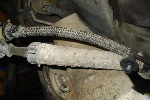jmvb
Well-Known Member
- Joined
- September 19, 2015
- Messages
- 198
- Reaction score
- 5
- Year, Model & Trim Level
- 1998 Explorer XLT
Hi guys
My 98' XLT comes without Tstat, so, the truck take a long time to warm
It found a OEM Tstat, and it put it. Now, the truck warm fast, and the gauge stay right in the middle.
Few weeks ago, I saw coolant residues in the plastic tank.
Later, after a 100K trip, I heard a pressure air leak in the radiator cap area, and the water in the tank was boiling
I did change the hose zip. The air leak and the boiling remain
I did change the radiator cap, because it isn't a right one (only 15psi), and I had to add 4 lt of coolant.
I continue see coolant residues in the plastic tank cap (it is 1/4 fulll), and no more air leak, but I'm not sure about the boiling, because I'm only had drive into the city relative short distances, no long highway travels.
It is normal?
My 98' XLT comes without Tstat, so, the truck take a long time to warm
It found a OEM Tstat, and it put it. Now, the truck warm fast, and the gauge stay right in the middle.
Few weeks ago, I saw coolant residues in the plastic tank.
Later, after a 100K trip, I heard a pressure air leak in the radiator cap area, and the water in the tank was boiling
I did change the hose zip. The air leak and the boiling remain
I did change the radiator cap, because it isn't a right one (only 15psi), and I had to add 4 lt of coolant.
I continue see coolant residues in the plastic tank cap (it is 1/4 fulll), and no more air leak, but I'm not sure about the boiling, because I'm only had drive into the city relative short distances, no long highway travels.
It is normal?

 :exp:
:exp:









